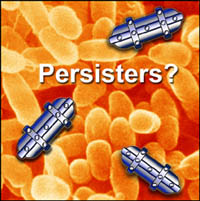Persister hypothesis

Cells may turn into "persisters"
The "persister" is a hypothetical cell state in which microorganisms are protected from all types of antimicrobial insults. This hypothesis has been developed to explain "kill versus time" curves and "kill versus concentration" curves that exhibit tailing. Even when biofilms are treated for prolonged periods of time or with elevated antimicrobial concentrations, a small fraction of the population persists.Persisters may constitute one percent or less of a biofilm population.
Though small in relative numbers, this protected subpopulation is sufficient to reseed the biofilm in the event of catastrophic chemical or physical challenge.
No one has yet identified a persister cell, but persisters have alternately been imagined as spore-like cells that are dormant and incapable of growth and as phenotypic variants that grow as rapidly as the parent strain (Spoering and Lewis, 2001; Drenkard and Ausubel, 2002). It is likely that persisters exist in planktonic cultures as well as in biofilms, but because biofilms experience nutrient limitation, they may form in higher numbers in biofilms than in planktonic culture. Finding cells in the persister state will be difficult. They might not be detected on gene arrays or by proteomic analysis. In addition to being present in low numbers, this state is probably ephemeral; an assumption implicit to the persister hypothesis is that these protected cells can revert to a susceptible state. Finally, if the persister state is linked to nutrient limitation or stationary phase existence, then a full understanding of this mechanism will require analysis of nutrient transport and spatial patterns of growth within biofilms.
If genes responsible for the differentiation exist, these genes might include those encoding regulatory circuits that determine the entry and exit from the persister state as well as specific protective responses. One can imagine interrupting the pathway for this differentiation to prevent persister formation, even if a culture does enter stationary phase.

